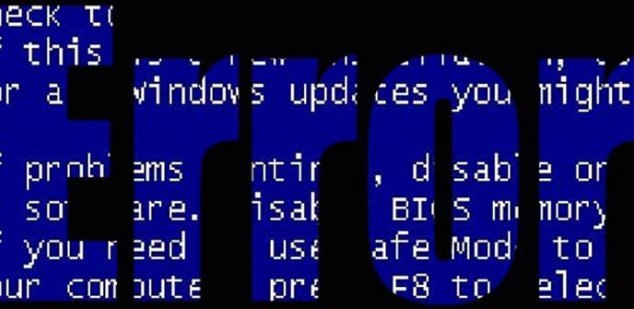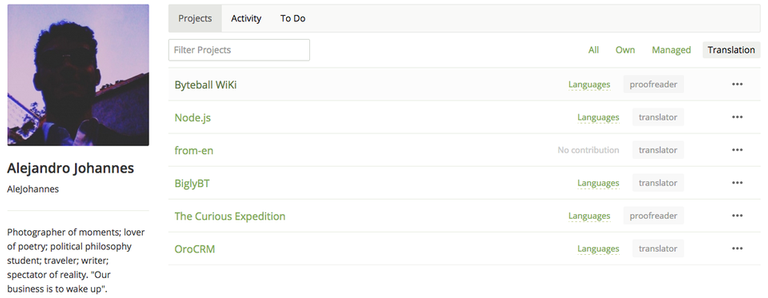Github Repository
https://github.com/nodejs/i18n
Project Details
By definition, Node.js is a Java Runtime Environment (JRE). But it is more than just that. While common JREs function as machine backups that allow users to smoothly run JavaScript on their browsers and applications, this open-source project functions as an app that manages Java code by itself. It's practical uses for developers are endless. It grants an extraordinarily versatile platform for designing code, programs, websites and other applications. And that isn't all: Node provides a virtual facility for testing the proper work of Java-driven programs and devices –and their planned updates–, helping to find bugs, solve errors, fix code and vastly improving their performance.
I believe all the amazing uses of Node are to be considered by themselves and I declare myself a fan of the project. But, besides, I support it for its functionality as a medium for bringing to reality countless creations that can be as good as Node itself. If you can dream it –and code it in JavaScript–, then your imagination is the only limit!The open translation of Node to thirty-three (33) languages proves the advantages of open-source projects when it comes to diversification of knowledge and worldwide spreading of useful tools.
Ahead, there is the link of the program's webpage:
Contribution Specifications
Translation Overview
This is my 38th contribution to Node.js as a translator. For this collaboration, I started the translation of the errors.md file of Node.js' version 6, which contains the documentation of the error processes and their handling within the program.
First, we need to define what "errors" are in the context of computer science:

Errors are the processes through which unwanted or unexpected behaviors are unchained in the regular course of action of a particular software. These can occur by a lot of diverse reasons and, so, they show themselves as a whole set of different disruptions in the normal realization of the tasks of programs. Some of the most common of them are:
Syntax errors: in which users (or a flaky program) fail to use the proper syntax of the programming language used by the machine they’re working on and its programs cannot process the information being inputted.
Arithmetical errors: in which a program is required to realize a mathematically impossible operation and doesn’t have a procedure mechanism for the case of failure of its tasks.
Inexistent files or directories: in which a program is determined to access to a file or location in the virtual machine that does not exist.
Corruption of data: in which data that should be readable by the computer, surprisingly, it’s not. This might happen by bugs in data transferring, internal problems with the programs that originate said data or user-provoked distortion.
Soft errors: in which data that is currently being processed is altered by the decaying of the materials of the internal memory or other components of a computer. These can usually be fixed by cooling down and rebooting the equipment, only resulting in the alteration of said data, not having damaged the hard-drive (physical parts) of the computer.
Hard errors: are permanent damages to the hard-drive of a computer that makes it unreliable to succeed at certain operations.
Fatal exception errors: in which the component responsible to communicate with the program and handle certain error as an exception –I’ll get to explain what’s this and what I’m talking about– fails and leaves the machine without a procedure to follow.

That being said, we can discuss what is error handling, or, more exactly, what is exception handling? Since we’re discussing Node.js, it is proper to explain that in JavaScript errors are dealt with as exceptions, understanding exceptions events that interferes with the normal flow of a program and its operations. By documenting and treating errors as possible unexpected events, one can define a set of routines to be executed as soon as these appear. This can prevent the program from collapsing and crashing.
In the JavaScript logic, errors, then, differentiate from bugs, as:
- 1 ) Errors are predictable and can be managed. They fit in categories of exceptions, each of one corresponding with an action plan to be “handled”.

- 2 ) Bugs are occurrences that –in a manner of speech– creep the heck out of developers and users, as they’re not documented, they are unpredictable and nobody knows what is happening when these start showing up.

So, just to make it clear:
Me when I find a bug versus me when I find an exception:

We can now list and a few JavaScript common errors that are defined in the translated document. These are:
{EvalError}; {SyntaxError}; {RangeError}; {ReferenceError}; {TypeError}; {URIError}; System errors triggered by underlying operating system constraints; User-specified errors triggered by application code; and Assertion Errors.
Later (very soon), I’ll explain these types of errors. I’m not doing it now so I can keep you hooked on my posts... MUHAHAHAHAH! ⚡
You can find out more about the aforementioned concepts here:
- https://www.geeksforgeeks.org/exceptions-in-java
- https://www.webopedia.com/TERM/S/soft_error.html
- https://www.webopedia.com/TERM/S/soft_error.html
- https://www.webopedia.com/TERM/F/fatal_exception_error.html
- https://www.javatpoint.com/exception-handling-in-java
- https://es.wikipedia.org/wiki/Error_de_software
Thanks for taking your time to read! Expect more information and tips on the next report :)

Work example #01:
English:
Node.js supports several mechanisms for propagating and handling errors that
occur while an application is running.
Spanish:
El siguiente ejemplo ilustra el uso de la clase <0>readline.Interface</0> para implementar una interfaz de línea de comandos pequeña
Work example #02:
English:
With few exceptions, <0>Synchronous</0> APIs (any blocking method that does not accept a <1>callback</1> function, such as <1>fs.readFileSync</1>][]), will use <1>throw</1> to report errors.
Spanish:
Con pocas excepciones, las APIs <0>Sincrónicas</0> (cualquier método que no acepte una función <1>callback</1>, tal como [<1>fs.readFileSync</1>][]), utilizarán <1>throw</1> para reportar errores.
Work example #03:
English:
For <0>all</0> <1>EventEmitter</1> objects, if an <1>'error'</1> event handler is not provided, the error will be thrown, causing the Node.js process to report an unhandled exception and crash unless either: The <2>domain</2> module is used appropriately or a handler has been registered for the [<1>process.on('uncaughtException')</1>][] event.
Spanish:
Para <0>todos</0> los objetos <1>EventEmitter</1>, si no se proporciona un manejador del evento <1>'error'</1>, se arrojará el error, ocasionando que el proceso de Node.js reporte una excepción no manejada y colapse, a menos que: El módulo <2>domain</2> sea utilizado de manera apropiada o se haya registrado un manejador para el evento [<1>process.on('uncaughtException')</1>][].
Languages
This translation was made from English to Spanish.
I got plenty experience translating and proofreading this project as an Utopian contributor. I collaborate here as translator and Language Moderator of the Da-Vinci/Utopian Spanish translation team. Besides this project, I have experience translating and proofreading The Curious Expedition, Ancap-ch, Byteball Wiki, OroCrm and BiglyBT.
Word Count
- The amount of words translated in this contribution is: 1,218.
Note: This number is the result of subtracting the complete sum of non-translatable content to the word-count Crowdin has done for the period in which this contribution was done.
- The total amount of words translated in this project (as a Da-vinci/Utopian translator) is: 47,368.
Previous Translations of the Project
- Contribution N'01. Submitted on September 13th, 2018.
- Contribution N'02. Submitted on September 15th, 2018.
- Contribution N'03. Submitted on September 17th, 2018.
- Contribution N'04. Submitted on September 19th, 2018.
- Contribution N'05. Submitted on September 21th, 2018.
- Contribution N'06. Submitted on September 22th, 2018.
- Contribution N'07. Submitted on September 23th, 2018.
- Contribution N'08. Submitted on October 1st, 2018.
- Contribution N'09. Submitted on October 8th, 2018.
- Contribution N'10. Submitted on October 14th, 2018.
- Contribution N'11. Submitted on October 15th, 2018.
- Contribution N'12. Submitted on October 18th, 2018.
- Contribution N'13. Submitted on October 21st, 2018.
- Contribution N'14. Submitted on October 24th, 2018.
- Contribution N'15. Submitted on October 27th, 2018.
- Contribution N'16. Submitted on October 31th, 2018.
- Contribution N'17. Submitted on November 3rd, 2018.
- Contribution N'18. Submitted on November 4th, 2018.
- Contribution N'19. Submitted on November 6th, 2018.
- Contribution N'20. Submitted on November 17th, 2018.
- Contribution N'21. Submitted on November 24th, 2018.
- Contribution N'22. Submitted on December 7th, 2018.
- Contribution N'23. Submitted on December 15th, 2018.
- Contribution N'24. Submitted on December 20th, 2018.
- Contribution N'25. Submitted on December 26th, 2018.
- Contribution N'26. Submitted on December 28th, 2018.
- Contribution N'27. Submitted on December 30th, 2018.
- Contribution N'28. Submitted on January 9th, 2019.
- Contribution N'29. Submitted on January 10th, 2019.
- Contribution N'30. Submitted on January 12th, 2019.
- Contribution N'31. Submitted on January 18th, 2019.
- Contribution N'32. Submitted on January 19th, 2019.
- Contribution N'33. Submitted on January 24th, 2019.
- Contribution N'34. Submitted on January 28th, 2019.
- Contribution N’35. Submitted on January 31st, 2019.
- Contribution N’36. Submitted on March 3rd, 2019.
- Contribution N’37. Submitted on March 6th, 2019.
Proof of Authorship
This translation was made between March 7th and 19th. You can check the translation record in my Crowdin account [here], the activity on the project's Crowdin [here] and a summary of recent additions to the project [here].


Hi @alejohannes,
Thank you for submitting your contribution!
Node.js is a very interesting project that contains many code values and terms related to computer science. Its difficulty relies on the fact that we must pay a lot of attention to the code in order to deliver the most accurate translation possible.
Your presentation post is informative, provides useful and relevant information, as well as your personal feedback in a very dynamic way. The visual presentation of the post is also very good and fun to read. Kudos for always adding your personal touch to the report :)
Your wording and spelling are correct and appropriate for the Spanish language and for the project.
Keep up the good work!
Your contribution has been evaluated according to Utopian policies and guidelines, as well as a predefined set of questions pertaining to the category.
To view those questions and the relevant answers related to your post, click here.
Chat with us on Discord
Thank you for your review, @marugy99! Keep up the good work!
Hi @alejohannes!
Feel free to join our @steem-ua Discord serverYour post was upvoted by @steem-ua, new Steem dApp, using UserAuthority for algorithmic post curation! Your post is eligible for our upvote, thanks to our collaboration with @utopian-io!
The beginning you mention Java quite a few times, which nodejs is all JavaScript , jre and Java are nowhere in sight. I'd go through a second or third time and double check all the translations...
Hi, @sn0n! Translations are checked, double-checked and proofread. This is a multidisciplinary team that has the vocation of contributing to open-source projects. I'm not a developer (my area of expertise is social sciences, actually, haha), but I'm a translation enthusiast and try to share some basic knowledge on concepts that are important to the projects I translate, so the readers –that might be as inexpert as me– can have a ground to stand and understand the particular context of each contribution.
Thank you for your valuable feedback! I invite you to check on my past contributions, where I address a lot of other important terminology of Node.js 👾
GIF source
Hey, @alejohannes!
Thanks for contributing on Utopian.
We’re already looking forward to your next contribution!
Get higher incentives and support Utopian.io!
SteemPlus or Steeditor). Simply set @utopian.pay as a 5% (or higher) payout beneficiary on your contribution post (via
Want to chat? Join us on Discord https://discord.gg/h52nFrV.
Vote for Utopian Witness!